Valve coking and direct injection engines
#51
AudiWorld Senior Member
The DFI engines produce more soot and this will turn the the color of the oil dark/black sooner. The Diesels I have had in the past turned the oil black within a thousand miles or so. It means there is soot in the oil and the oil detergent package is doing its job in keeping it dispersed. The question, I believe, is how much of that oil is being directed to the intake valve area.
Ah, that makes a lot of sense thanks Fahrer. Very good chance my gut instinct to go nuts on short oil change intervals is reactionary and not warranted assuming that the oil does indeed hold the contaminents in suspense, so to speak. Still, I see no harm in doing an intermediate oil change every 5K miles.
#52
The dark color is as Faher correctly states caused by the additional particulate matter entering the crankcase, but unlike a diesel where this is mainly soft soot and can remain in suspension causing little wear, the particulate matter in the GDI engine is a very hard crystalline (for the most part, early deposits are a bit softer) make up and very abrasive. And as app. 70% of all wear is caused by particulate matter smaller than the 10-15 microns most oil filter trap down to, this is a good part of what is causing the wear to the engine in general. The valve guides are a softer brass alloy and the deposits on the valve stem are drawn into the guides with each cycle causing wear to them pretty rapidly. So it is not that the DI engines create more soot that enters discoloring the oil early on, but that the soot/ash/carbon is referred to at SAE as "hard carbon" and this is very abrasive.
To clarify the 50k mile wear, no, I am not saying all engines will be worn out by 50k miles. Just that this is the point many will be showing symptoms that will require service visits and that is where the cost and long term liability comes in as far as the automakers. We see failures as soon as 20k or less miles in some cases, but this is not the norm. This is a rid bear set (or was) just removed from a 28k miles GDI engine:
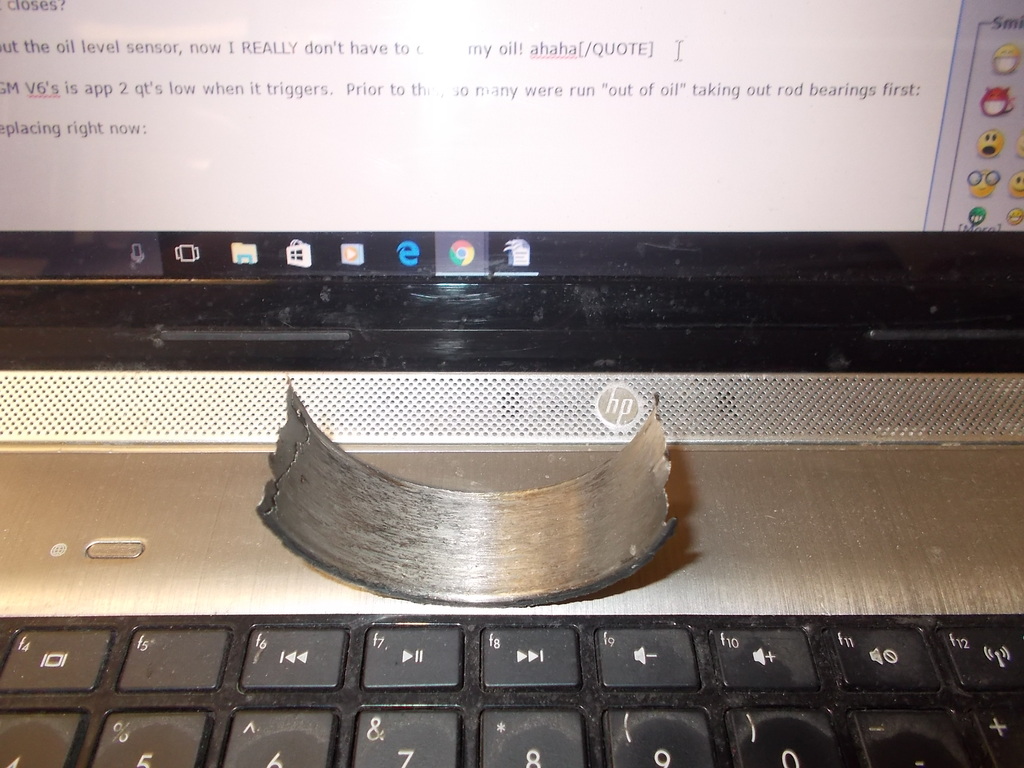
And of course there are and will be plenty with 100k miles on that have not shown severe enough symptoms for the average driver to realize there are problems. This is just what the industry is targeting. The average new vehicle buyer trades within 3 years, and will have no more than 36k miles on in that time period so they are looking at warranty claim averages. The goal of every automaker is to sell as many new vehicles as possible, and as this is an industry wide problem, the used market is not of concern, only how to get these to go past the warranty period with the least customer noticeable issues, and we all know the average owner does not even open their hood much less pay attention to any of this. They buy the vehicle and aside from putting in fuel when needed, or seeing a dash prompt to visit for service, they just drive them and pay little attention to performance and other issues unlike most members of this forum that are in tune with their cars.
I would NOT go any longer than 5k miles on any GDI engine between changes.
Here is a 2015 with 4,200 miles on it:
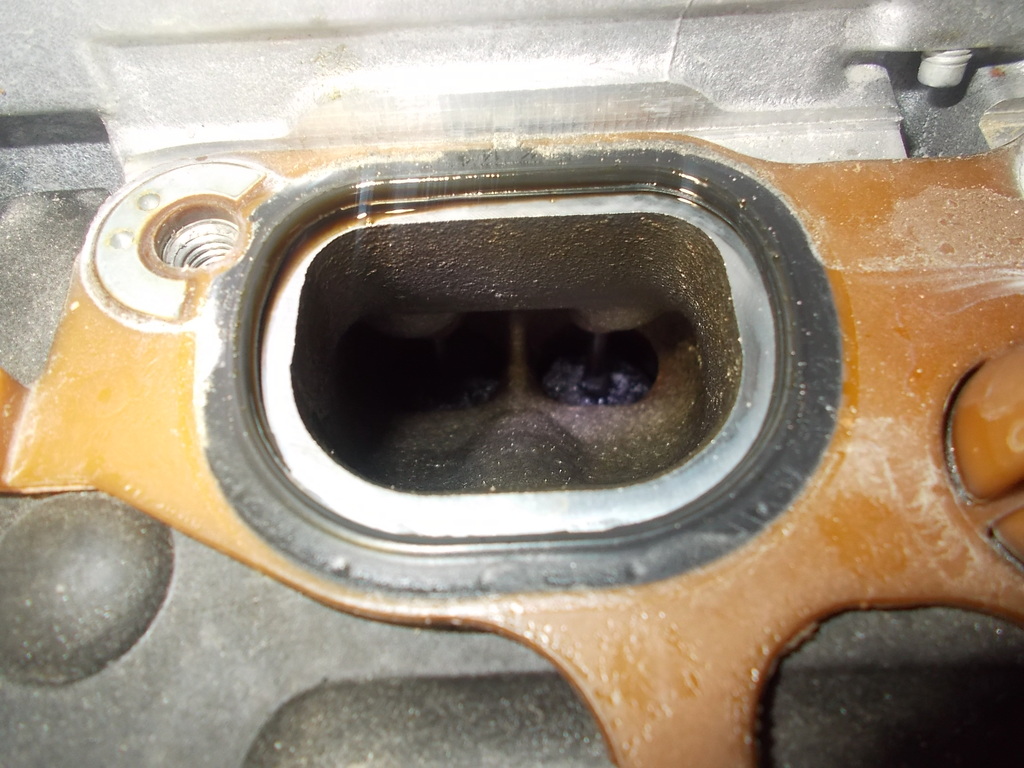
The 2 cylinder closest to the point of ingestion are already horrible, but the deposits have not been subject to the heat long enough to form the very hard abrasive crystalline deposits, these at this point are relatively easy to remove. Now the rest of the ports have almost no deposits showing on them also validating what is causing the deposits:
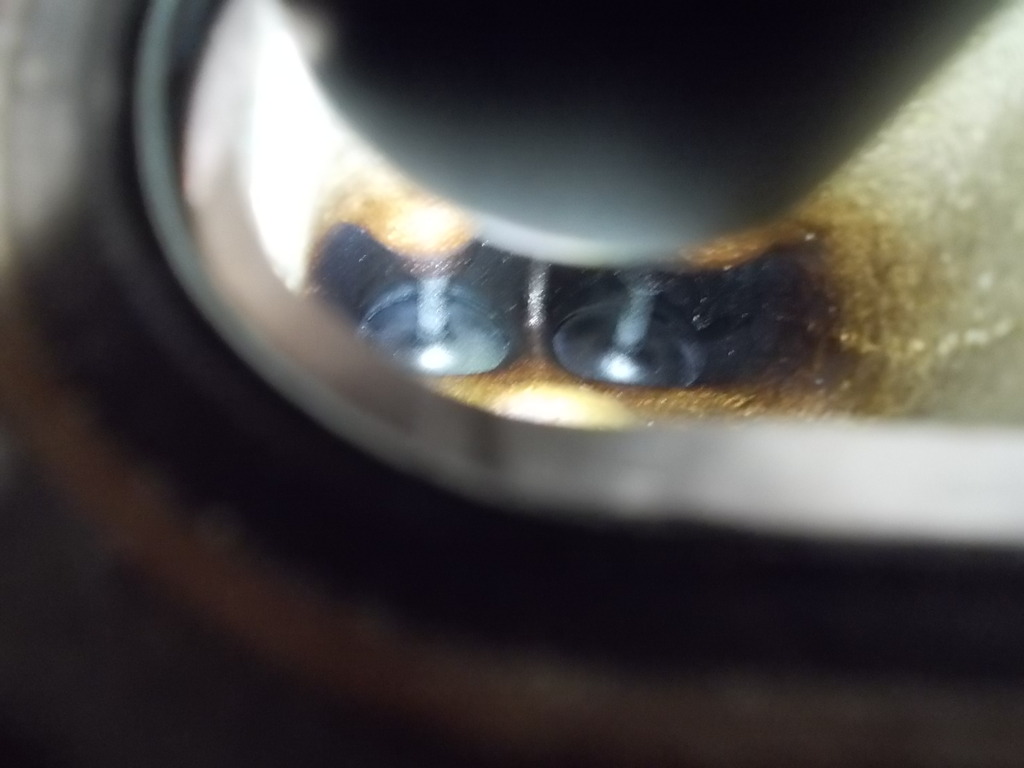
The problem here is as the upstream O2 sensors are measuring the entire bank as a whole, the ECU will command each injector on that bank to deliver the same amount of fuel. But as less air charge is entering those with greater deposits on the valves of that cylinder, they will actually run richer than optimum. The cylinders with the last deposits will run leaner than optimum so the engine as a whole no longer produces the same amount of power or run as efficiently and as when new, and emissions increase as well due to this. Mitch may chime in to how his fuel economy has improved as well. When you clean valves, and have the oil and other contaminates removed from the PCV vapors entering as part of the intake air charge, the combustion process is more complete and produces more energy and less detonation caused knock retard allowing longer periods of optimum timing advance thus more power and better fuel economy (only 1-3 mpg average, but still an increase.)
As for the wear again, at 20-30-40k miles most we inspect have already worn to just at or beyond acceptable tolerances. This of course is rarely noticed by any but those running at extended high RPM's when power can drop due to instability of the valves. But, this also allows more oil to enter via the valve seal and guide, where this had disappeared in all port injection engines of the past (who is old enough to remember back in the carbureted days having to do a valve job at 30-40K miles as standard?) When port injection became the standard, no deposits were forming on any part of the valves backside. Even at 200k plus miles, so worn guides were only happening if a material defect was the cause or a initial machining error caused the seat to be out of square with the guide and the side forces caused wear (google search "LS7 valve failures" to read about a widespread case of this) and eventual failure of the valve itself.
Here are some examples of extensive lab testing of both the oil, and the mixture caught in the more effective air/oil separation systems like Mitch installed.
First, here is what is caught in the average system that would have entered the intake air charge and contributed to this issues:
70% acidic water (the water and sulfuric acid mix when in a separator).
23% raw fuel (this is removed from the crankcase before it can settle and mix with the oil diluting it).
7% is oil and abrasive particulate matter. Spun in a centrifuge it separates into 4-5 distinct layers, with the acidic water on the bottom. and oil at the very top.
Now lets look at a controlled test of the engine oil and how a system like Mitche's evacuates and removes much of this before it can mix with the oil:
This is 2013 GDI vehicle. Oil is a premium full synthetic and test sample extracted at 5,943 miles on this oil:
Water: <0.05
Fuel: 4.5
Visc@40: 45.71
Visc@100: 8.76
Solids: trace
Oxidation: 7.78
Nitrates: 4.29
TBN (oils ability to neutralize acid): 7.38
Fe: 42
Cr: 0
Pb: 0
Cu: 1
Sn:0
Al: 1
Ni: 0
Ag: 0
Mn: 0
Si:12
B: 118
Na: 7
Ca: 3428
P: 661
Zu: 746
Mo: 118
Now, at 9411 miles on the same oil:
Water: 0.05
Fuel: (note, this normally would have risen): 3.86
Viscosity@40 (has actually increased!): 46.97
Viscosity@100 : 8.82
Solids: Trace
Oxidation: 21.11
Nitrates: 48.57
TBN (still above where many oils start and degrade from): 5.06
Fe: 70
Cr: 1
Pb: 0
Cu: 10
Sn: 0
Al: 1
Ni: 0
Ag: 0
Mn: 0
Si: 14
B: 90
Na: 8
Ca: 3,430
P: 628
Zn: 679
Mo: 118
So you can see (aside from this being a premium full syn oil) wear level indicators are below where they normally would be at close to 10k miles since change, but viscosity has improved (normally would have degraded far more), Fuel is far less than normal samples, and all around great looking. So the system actually is removing much of these compounds not only before they could settle, but this contributed to reductions in other contaminate levels and healthy wear indicators.
The amount of oil entering the combustion chamber from the rings is minimal when rings are seated properly, and almost nothing comes past valve seals and guides, so 90-95% is entering via the PCV system vapors where they make contact with the back sides of the valves and bake on to the valves. The rest comes from the variable valve and fueling events that emulate the old EGR's functions allowing burnt gasses to back fill to the valves backside for a small amount to be re-burned.
Ask more in detail on any of this. This is a good discussion going here.
Fahrer, and chance we could get you to remove the intake manifold from either the Golf or the Audi and take some pictures of your valves and the miles at the time? Very easy and requires minimal tools to inspect. A boroscope threaded down intake runners from the TB mount is difficult due to the runner and plenum design, but you may be able to do so.
That will give you and the rest here an actual example on a relatively new GDI engine with the latest in improvements to slow these deposits and how well it is actually working.
A personal example of the modern Diesels (well a decade old and then some) we purchased a TDI Jetta in 2004, and ran it pretty trouble free for 264k miles before we sold it (still running strong). Other than a clutch/PP change and a turbo swap, that engine just ran and ran.
To clarify the 50k mile wear, no, I am not saying all engines will be worn out by 50k miles. Just that this is the point many will be showing symptoms that will require service visits and that is where the cost and long term liability comes in as far as the automakers. We see failures as soon as 20k or less miles in some cases, but this is not the norm. This is a rid bear set (or was) just removed from a 28k miles GDI engine:

And of course there are and will be plenty with 100k miles on that have not shown severe enough symptoms for the average driver to realize there are problems. This is just what the industry is targeting. The average new vehicle buyer trades within 3 years, and will have no more than 36k miles on in that time period so they are looking at warranty claim averages. The goal of every automaker is to sell as many new vehicles as possible, and as this is an industry wide problem, the used market is not of concern, only how to get these to go past the warranty period with the least customer noticeable issues, and we all know the average owner does not even open their hood much less pay attention to any of this. They buy the vehicle and aside from putting in fuel when needed, or seeing a dash prompt to visit for service, they just drive them and pay little attention to performance and other issues unlike most members of this forum that are in tune with their cars.
I would NOT go any longer than 5k miles on any GDI engine between changes.
Here is a 2015 with 4,200 miles on it:

The 2 cylinder closest to the point of ingestion are already horrible, but the deposits have not been subject to the heat long enough to form the very hard abrasive crystalline deposits, these at this point are relatively easy to remove. Now the rest of the ports have almost no deposits showing on them also validating what is causing the deposits:

The problem here is as the upstream O2 sensors are measuring the entire bank as a whole, the ECU will command each injector on that bank to deliver the same amount of fuel. But as less air charge is entering those with greater deposits on the valves of that cylinder, they will actually run richer than optimum. The cylinders with the last deposits will run leaner than optimum so the engine as a whole no longer produces the same amount of power or run as efficiently and as when new, and emissions increase as well due to this. Mitch may chime in to how his fuel economy has improved as well. When you clean valves, and have the oil and other contaminates removed from the PCV vapors entering as part of the intake air charge, the combustion process is more complete and produces more energy and less detonation caused knock retard allowing longer periods of optimum timing advance thus more power and better fuel economy (only 1-3 mpg average, but still an increase.)
As for the wear again, at 20-30-40k miles most we inspect have already worn to just at or beyond acceptable tolerances. This of course is rarely noticed by any but those running at extended high RPM's when power can drop due to instability of the valves. But, this also allows more oil to enter via the valve seal and guide, where this had disappeared in all port injection engines of the past (who is old enough to remember back in the carbureted days having to do a valve job at 30-40K miles as standard?) When port injection became the standard, no deposits were forming on any part of the valves backside. Even at 200k plus miles, so worn guides were only happening if a material defect was the cause or a initial machining error caused the seat to be out of square with the guide and the side forces caused wear (google search "LS7 valve failures" to read about a widespread case of this) and eventual failure of the valve itself.
Here are some examples of extensive lab testing of both the oil, and the mixture caught in the more effective air/oil separation systems like Mitch installed.
First, here is what is caught in the average system that would have entered the intake air charge and contributed to this issues:
70% acidic water (the water and sulfuric acid mix when in a separator).
23% raw fuel (this is removed from the crankcase before it can settle and mix with the oil diluting it).
7% is oil and abrasive particulate matter. Spun in a centrifuge it separates into 4-5 distinct layers, with the acidic water on the bottom. and oil at the very top.
Now lets look at a controlled test of the engine oil and how a system like Mitche's evacuates and removes much of this before it can mix with the oil:
This is 2013 GDI vehicle. Oil is a premium full synthetic and test sample extracted at 5,943 miles on this oil:
Water: <0.05
Fuel: 4.5
Visc@40: 45.71
Visc@100: 8.76
Solids: trace
Oxidation: 7.78
Nitrates: 4.29
TBN (oils ability to neutralize acid): 7.38
Fe: 42
Cr: 0
Pb: 0
Cu: 1
Sn:0
Al: 1
Ni: 0
Ag: 0
Mn: 0
Si:12
B: 118
Na: 7
Ca: 3428
P: 661
Zu: 746
Mo: 118
Now, at 9411 miles on the same oil:
Water: 0.05
Fuel: (note, this normally would have risen): 3.86
Viscosity@40 (has actually increased!): 46.97
Viscosity@100 : 8.82
Solids: Trace
Oxidation: 21.11
Nitrates: 48.57
TBN (still above where many oils start and degrade from): 5.06
Fe: 70
Cr: 1
Pb: 0
Cu: 10
Sn: 0
Al: 1
Ni: 0
Ag: 0
Mn: 0
Si: 14
B: 90
Na: 8
Ca: 3,430
P: 628
Zn: 679
Mo: 118
So you can see (aside from this being a premium full syn oil) wear level indicators are below where they normally would be at close to 10k miles since change, but viscosity has improved (normally would have degraded far more), Fuel is far less than normal samples, and all around great looking. So the system actually is removing much of these compounds not only before they could settle, but this contributed to reductions in other contaminate levels and healthy wear indicators.
The amount of oil entering the combustion chamber from the rings is minimal when rings are seated properly, and almost nothing comes past valve seals and guides, so 90-95% is entering via the PCV system vapors where they make contact with the back sides of the valves and bake on to the valves. The rest comes from the variable valve and fueling events that emulate the old EGR's functions allowing burnt gasses to back fill to the valves backside for a small amount to be re-burned.
Ask more in detail on any of this. This is a good discussion going here.
Fahrer, and chance we could get you to remove the intake manifold from either the Golf or the Audi and take some pictures of your valves and the miles at the time? Very easy and requires minimal tools to inspect. A boroscope threaded down intake runners from the TB mount is difficult due to the runner and plenum design, but you may be able to do so.
That will give you and the rest here an actual example on a relatively new GDI engine with the latest in improvements to slow these deposits and how well it is actually working.
A personal example of the modern Diesels (well a decade old and then some) we purchased a TDI Jetta in 2004, and ran it pretty trouble free for 264k miles before we sold it (still running strong). Other than a clutch/PP change and a turbo swap, that engine just ran and ran.
#53
AudiWorld Senior Member
GDI, so for those of us who don't want to risk VAG voiding our warranty it seems to me that all we can do is (i) use only top tier fuel, (ii) adopt early oil change intervals, and (iii) try to avoid short trips that don't bring car up to normal operating temperature. I know from all of the information you have shared (i) and (ii) are correct -- not sure about (iii) Any other suggestions?
I find those images of the deposits on the valves disturbing to look at. I take pride in maintaining my vehicle to a high standard but despite so doing good chance the innards of my engine are going to look like those pics. Sad.
I came over to Audi from a 2006 Acura TL. We still have an 04 TL in the family that I'm using as my winter commute-buggy. The 04 has 150,000 miles on the clock. Runs like a car with half the miles or less. We've owned it since new and it has been the beneficiary of old school maintenance with 3500 mile oil change intervals (thank you Acura dealer for throwing in lifetime oil changes when we bought the car -- little did they know.....). I wonder if we tore down this 150,000 mile engine if it would look cleaner than my $60,000 A6's engine. I suspect the answer to that question may be yes. Progress? I'm not so sure.
Best,
Jeff
I find those images of the deposits on the valves disturbing to look at. I take pride in maintaining my vehicle to a high standard but despite so doing good chance the innards of my engine are going to look like those pics. Sad.
I came over to Audi from a 2006 Acura TL. We still have an 04 TL in the family that I'm using as my winter commute-buggy. The 04 has 150,000 miles on the clock. Runs like a car with half the miles or less. We've owned it since new and it has been the beneficiary of old school maintenance with 3500 mile oil change intervals (thank you Acura dealer for throwing in lifetime oil changes when we bought the car -- little did they know.....). I wonder if we tore down this 150,000 mile engine if it would look cleaner than my $60,000 A6's engine. I suspect the answer to that question may be yes. Progress? I'm not so sure.
Best,
Jeff
#54
AudiWorld Member
Join Date: Dec 2013
Location: Ontario, Canada
Posts: 278
Likes: 0
Received 0 Likes
on
0 Posts
So this is the part I don't get:
Yes, there is a potential problem to valve coking after 50k miles or so. Yes, it probably will affect the performance. Is it that significant? Probably not. Will it shut down a car in the middle of a winter storm? Probably not. I'm not sure about how much does the valve cleaning cost. I would assume $1,500 or so. So why in earth would you start changing your oil at 4k in order to "MAYBE" prolong the issue of valve coking. Notice the big maybe?
i have changed my oil at 600, 2000, 6,000 and whatever kms the computer told me. The oil analysis were all the same. There was no difference. This leads me to believe that the oil is holding up fine between the recomemded intervals. Granted I have a TDI, but this is still as per audi recomends.
Anyways, what I am saying is maybe you guys are worrying about this too much. The cost of additional oil changes will probably offset the "possible" cost of cleaning the valves. If this was a race car, that needed every ounce of power, I could relate. The reality is most owners won't even know about it, let alone be affected enough to have to clean the valves.
Furthermore, when the cars are 10+ years old, scar yards will be selling the 3.0T engines for <$3k. If the engine tanks because of the valves, buy another one and replace it.
Just saying
Yes, there is a potential problem to valve coking after 50k miles or so. Yes, it probably will affect the performance. Is it that significant? Probably not. Will it shut down a car in the middle of a winter storm? Probably not. I'm not sure about how much does the valve cleaning cost. I would assume $1,500 or so. So why in earth would you start changing your oil at 4k in order to "MAYBE" prolong the issue of valve coking. Notice the big maybe?
i have changed my oil at 600, 2000, 6,000 and whatever kms the computer told me. The oil analysis were all the same. There was no difference. This leads me to believe that the oil is holding up fine between the recomemded intervals. Granted I have a TDI, but this is still as per audi recomends.
Anyways, what I am saying is maybe you guys are worrying about this too much. The cost of additional oil changes will probably offset the "possible" cost of cleaning the valves. If this was a race car, that needed every ounce of power, I could relate. The reality is most owners won't even know about it, let alone be affected enough to have to clean the valves.
Furthermore, when the cars are 10+ years old, scar yards will be selling the 3.0T engines for <$3k. If the engine tanks because of the valves, buy another one and replace it.
Just saying
#55
AudiWorld Super User

Does how the car is driven have a direct bearing on coking? For example, if the car on average over a period of uses 35% of it's max power or rpms does that increase or decrease the potential to form valve deposits? City or interstate driving?
#56
GDI, so for those of us who don't want to risk VAG voiding our warranty it seems to me that all we can do is (i) use only top tier fuel, (ii) adopt early oil change intervals, and (iii) try to avoid short trips that don't bring car up to normal operating temperature. I know from all of the information you have shared (i) and (ii) are correct -- not sure about (iii) Any other suggestions?
I find those images of the deposits on the valves disturbing to look at. I take pride in maintaining my vehicle to a high standard but despite so doing good chance the innards of my engine are going to look like those pics. Sad.
I came over to Audi from a 2006 Acura TL. We still have an 04 TL in the family that I'm using as my winter commute-buggy. The 04 has 150,000 miles on the clock. Runs like a car with half the miles or less. We've owned it since new and it has been the beneficiary of old school maintenance with 3500 mile oil change intervals (thank you Acura dealer for throwing in lifetime oil changes when we bought the car -- little did they know.....). I wonder if we tore down this 150,000 mile engine if it would look cleaner than my $60,000 A6's engine. I suspect the answer to that question may be yes. Progress? I'm not so sure.
Best,
Jeff
I find those images of the deposits on the valves disturbing to look at. I take pride in maintaining my vehicle to a high standard but despite so doing good chance the innards of my engine are going to look like those pics. Sad.
I came over to Audi from a 2006 Acura TL. We still have an 04 TL in the family that I'm using as my winter commute-buggy. The 04 has 150,000 miles on the clock. Runs like a car with half the miles or less. We've owned it since new and it has been the beneficiary of old school maintenance with 3500 mile oil change intervals (thank you Acura dealer for throwing in lifetime oil changes when we bought the car -- little did they know.....). I wonder if we tore down this 150,000 mile engine if it would look cleaner than my $60,000 A6's engine. I suspect the answer to that question may be yes. Progress? I'm not so sure.
Best,
Jeff
Hi Jeff,
The Acura for 2006 was a PGM-FI engine, one of the last years for the port fuel injection version of the engine before they transitioned to GDI, so yes, that engine would IMHO be far better at your mileage than a GDI at 50k miles. I suspect if you removed your intake manifold, the valves would look similar to this:
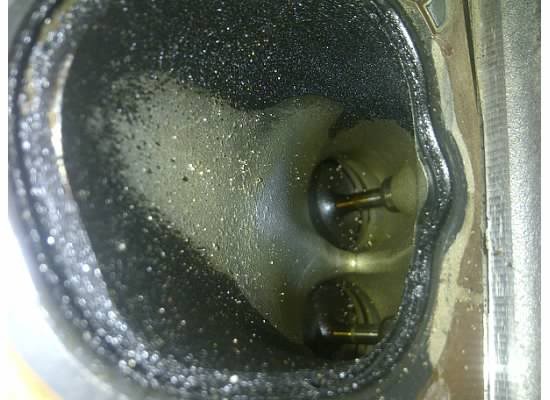
Ignore the white specs, that is just debris from the disassembly, but it is a engine similar to your Acura's with well over 100k miles. Not how you can see just where the fuel spray hit and zero coking at all.
Warranty in the US it is against Federal Law (search Magnuson/Moss act) to void your warranty for the installation of any aftermarket product unless that product can be proven to directly be the cause of the claim/failure. As the systems I mention are 100% emissions compliance, defeat or delete no functions of the factory PCV systems and retain a closed system, they cannot legally do so. And to date, only one instance of this ever happening and it turned out the tech misdiagnosed a bad oil pump and in the end the dealer was made to look pretty foolish publicly. But, the majority of systems (catchcans) sold out there can and do defeat or delete part or all of the factory PCV system functions giving cause to void warranty. So you have a good and valid concern. Now, if the dealer is not versed on the proper systems, they could cause trouble, so a good "mod friendly" dealer is key, or simply revert back to the stock system if going in for service. Not hard.
The top tier fuel has zero effect on the coking, but is critical to keep injectors clean and the spray pattern accurate.
A good premium full synthetic oil is probably the best step you can take due to the low amount of ash and residue produced when burnt. And going no more than 5k miles between changes (past port injection engines have been shown to go 15k plus miles between changes with a good full synthetic, but they were not subjecting the oil to so much in the way of contaminates as the GDI engines do.
Short trips also contribute to the issue, but that is hard to avoid.
We have a new Q7 coming in to inspect, so I will share that in the future as well.
The best solution is a combination of all of this.
#57
AudiWorld Senior Member
Duly noted Superfly.
As I've said in a previous post or two -- if need to do one cleaning during life of car not end of world. However, if 5K or slightly under oil change intervals might mitigate this problem I'm OK with that. I have Audicare so one or two extra oil changes done on a DIY basis during spring/summer/fall at a cost of maybe $70 per is cheap insurance in my opinion. Ultimately each of us will do what he or she is comfortable with.
As for the scrapyard I'm well beyond that stage in my life. Five to five and a half years is the upper limit of my expected period of ownership. With a bit of luck no walnut shells for me!
Best,
Jeff
As I've said in a previous post or two -- if need to do one cleaning during life of car not end of world. However, if 5K or slightly under oil change intervals might mitigate this problem I'm OK with that. I have Audicare so one or two extra oil changes done on a DIY basis during spring/summer/fall at a cost of maybe $70 per is cheap insurance in my opinion. Ultimately each of us will do what he or she is comfortable with.
As for the scrapyard I'm well beyond that stage in my life. Five to five and a half years is the upper limit of my expected period of ownership. With a bit of luck no walnut shells for me!
Best,
Jeff
#58
So this is the part I don't get:
Yes, there is a potential problem to valve coking after 50k miles or so. Yes, it probably will affect the performance. Is it that significant? Probably not. Will it shut down a car in the middle of a winter storm? Probably not. I'm not sure about how much does the valve cleaning cost. I would assume $1,500 or so. So why in earth would you start changing your oil at 4k in order to "MAYBE" prolong the issue of valve coking. Notice the big maybe?
i have changed my oil at 600, 2000, 6,000 and whatever kms the computer told me. The oil analysis were all the same. There was no difference. This leads me to believe that the oil is holding up fine between the recomemded intervals. Granted I have a TDI, but this is still as per audi recomends.
Anyways, what I am saying is maybe you guys are worrying about this too much. The cost of additional oil changes will probably offset the "possible" cost of cleaning the valves. If this was a race car, that needed every ounce of power, I could relate. The reality is most owners won't even know about it, let alone be affected enough to have to clean the valves.
Furthermore, when the cars are 10+ years old, scar yards will be selling the 3.0T engines for <$3k. If the engine tanks because of the valves, buy another one and replace it.
Just saying
Yes, there is a potential problem to valve coking after 50k miles or so. Yes, it probably will affect the performance. Is it that significant? Probably not. Will it shut down a car in the middle of a winter storm? Probably not. I'm not sure about how much does the valve cleaning cost. I would assume $1,500 or so. So why in earth would you start changing your oil at 4k in order to "MAYBE" prolong the issue of valve coking. Notice the big maybe?
i have changed my oil at 600, 2000, 6,000 and whatever kms the computer told me. The oil analysis were all the same. There was no difference. This leads me to believe that the oil is holding up fine between the recomemded intervals. Granted I have a TDI, but this is still as per audi recomends.
Anyways, what I am saying is maybe you guys are worrying about this too much. The cost of additional oil changes will probably offset the "possible" cost of cleaning the valves. If this was a race car, that needed every ounce of power, I could relate. The reality is most owners won't even know about it, let alone be affected enough to have to clean the valves.
Furthermore, when the cars are 10+ years old, scar yards will be selling the 3.0T engines for <$3k. If the engine tanks because of the valves, buy another one and replace it.
Just saying
You have a Diesel, so your oil analysis should show close to the same each time, if not you have something "going away" in the engine. My TDI went 260k miles w/out issue before selling it still going strong. This is mainly a GDI issue (Gasoline Direct Injection.
As for the cost of more frequent oil changes, that is a small price to pay for the peace of mind. And power is as soon as 5k miles where this drop can be documented.
The following are just a few examples of before dynos. the miles on the vehicle. a manual intake valve cleaning performed like this example:
All of these examples are fairly new cars, all GDI engines, and a variety of makes/models to demonstrate how widespread this is:
This first one is a small 4 cylinder Mini. 2012 with app 12k miles on it:
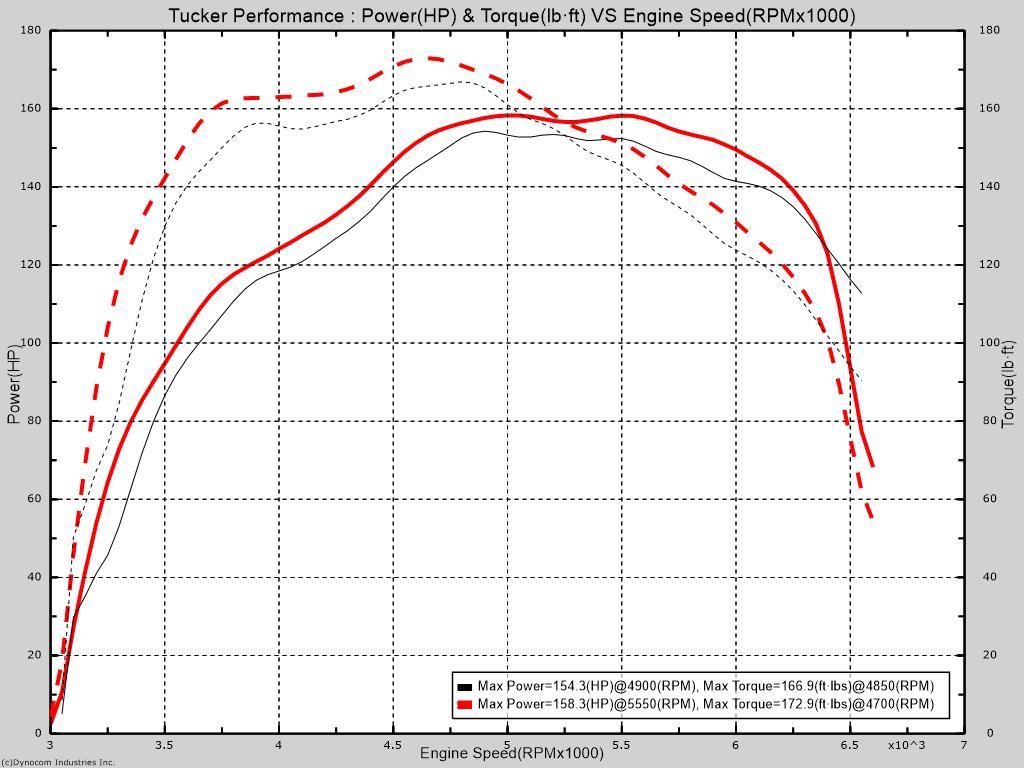
Fairly substantial. As with each of these, the vehicle owners that volunteered for the study all made statements to the effect : I would be surprised if there is any power loss, the car is almost new and I have not noticed any change", but after driving it post cleaning: "Wow, feels like a new engine!"
Now, here is a 2015 Corvette with GM's latest LT family of GDI V8's at 19 k miles:
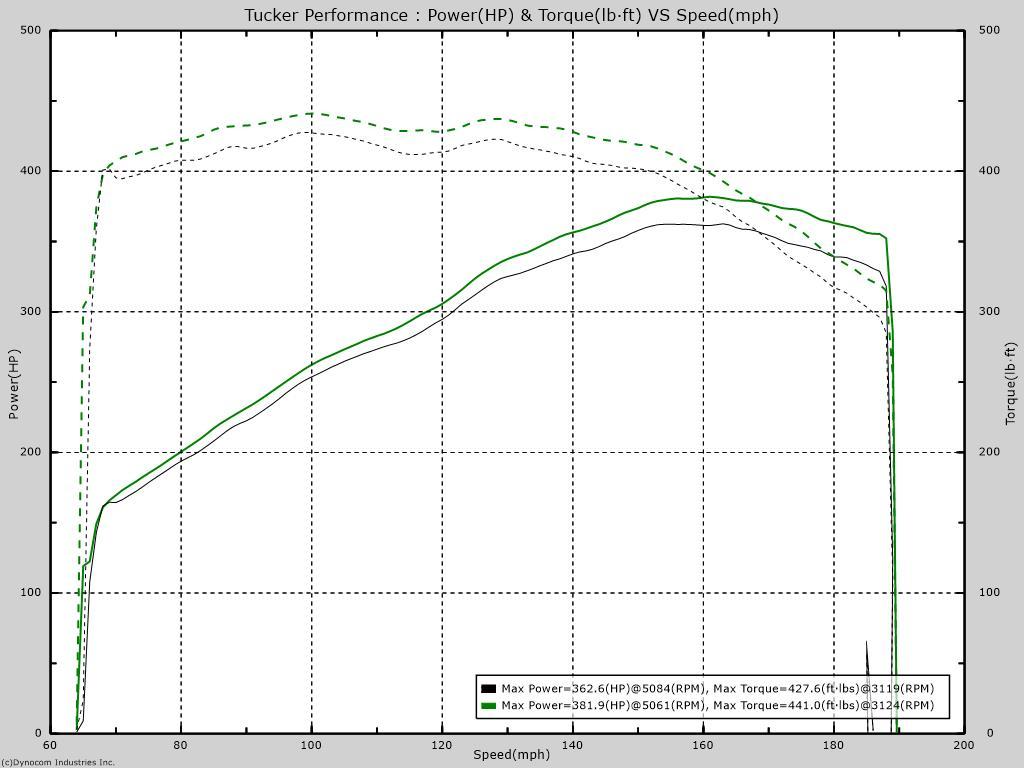 Nearly 20 RWHP regained, and this guy is an aerospace engineer that takes very careful care of all his vehicles.
Nearly 20 RWHP regained, and this guy is an aerospace engineer that takes very careful care of all his vehicles.This one is perhaps the longest study done by a BMW Tech on his new BMW 5 series. He started at app. one year old and then each year at app the same time he had a dyno done. Note how the power loss each time is on an increasing curve as once they become established, they form much more rapidly. Final run was after performing a manual intake valve cleaning himself:
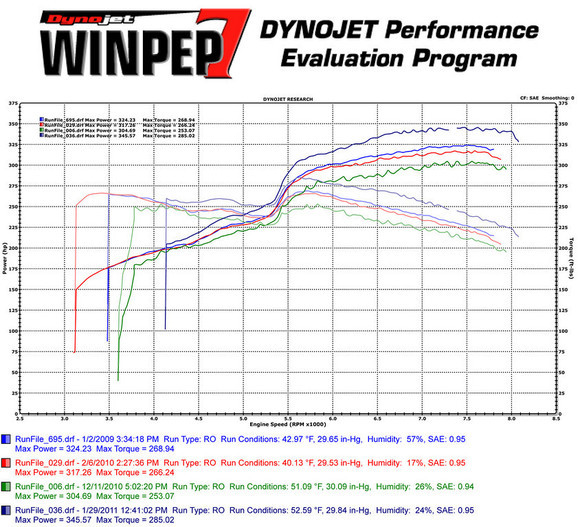
I can post dozens more, but these should get the message across.
I also have several different Audi late model GDI engines showing vales before and after cleaning, etc. but it would have far more credibility if some members here would remove their intake manifolds and show what they find and at the limes they are at, the type oil run, how often changed, etc. The small 4 cylinder engines are the easiest to remove and inspect.
#59
This one at 14k miles is the least we have ever seen, but owner drives normal with liking acceleration, and changed out factory fill oil at app 1000 miles and then has run nothing but a full synthetic since with changes every 5k miles:

Out of hundreds we have inspected and studied over the past 8 -9 years, none have shown as clean and little of deposits at 14k miles. Then the one I posted earlier at 4,200 miles is horrible. A big factor is how the rings seated during that brief few hundred miles when new. If driven easy, chances are there will be poor seating, and once the hard glaze forms over the cross-hatch hone pattern, there is little chance to further seat (at least on the road. In the lab in the dyno cells I have seen examples of engines run at WOT for extended periods still able to cut through the glaze and further seat). The more blow-by, the more oil consumption, the worse we see the formation.
#60
AudiWorld Senior Member
GDI, thanks very much for your response in post #56. In short my plan is to change oil every 4 months or 5,000 miles, whichever comes first and start driving with a lot more gusto than I have been thus far! And oh yeah, I'm on the prowl for a 2008 Acura TL with no more than 20,000 miles on the clock! Back to the future! LOL. Thanks again for your insight and knowledge on this topic.

